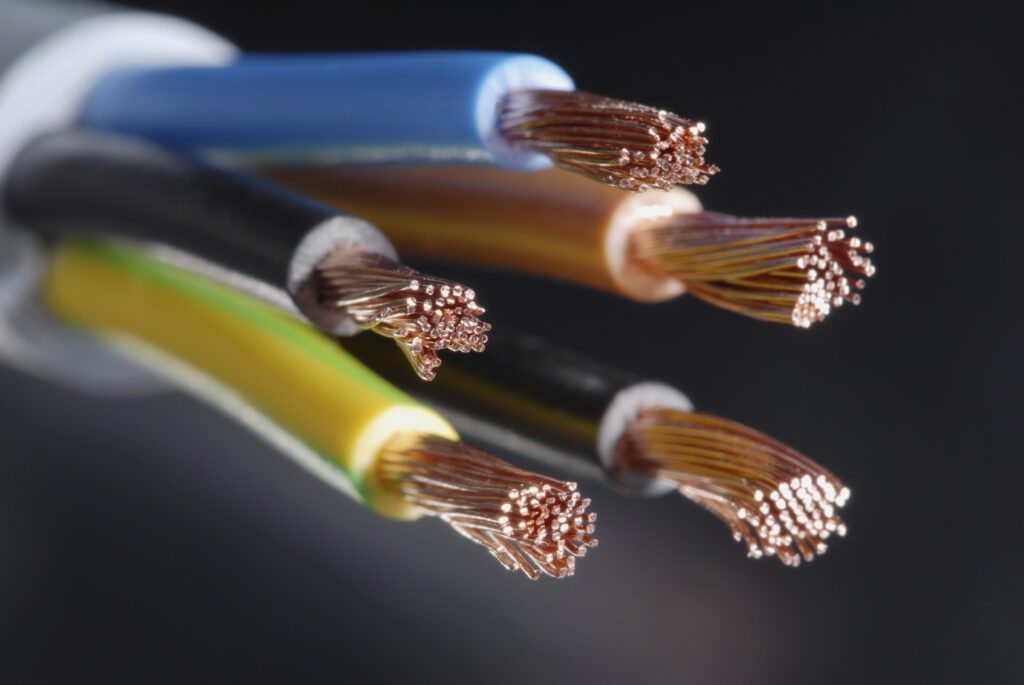USPTO Wire & Cable Industry Patents
Compiled from: United States Patent and Trademark Office (USPTO)
Flat Conductor Wire
United States Patent 10,804,007
Issued October 13, 2020
Inventor: Noriyuki Abe, Susono, Japan
Assignee: Yazaki Corporation, Tokyo, Japan
A flat conductor wire includes a flat conductor made of aluminum containing inevitable impurities.
A cross section of the flat conductor orthogonal to a longitudinal direction of the flat conductor has
a rounded corner portion, a radius of curvature of the corner portion being equal to or greater than
one fourth of a thickness of the cross section of the flat conductor. A width of the cross section of
the flat conductor is equal to or smaller than 60.epsilon./(1-.epsilon.), being a uniform elongation of
the flat conductor.
Twinax Cable and Multi-Core Cable
United States Patent 10,804,009
Issued October 13, 2020
Inventors: Nayu Yanagawa, Osaka, Japan; Shinya Nishikawa, Osaka, Japan; Taro Fujita, Osaka, Japan;
Yuto Kobayashi, Kanuma, Japan; Masaki Hayakawa, Kanuma, Japan; Atsushi Tsujino, Kanuma, Japan;
Yuji Ochi, Kanuma, Japan
Assignee: Sumitomo Electric Industries, Ltd., Osaka, Japan
A twinax cable 100 includes a twinax structure, the twinax structure including: a signal wire pair, the
signal wire pair including a pair of signal wires formed of a first signal wire and a second signal wire,
and an insulating layer configured to cover the pair of signal wires; a drain wire; and a shield tape
arranged on the outer circumferential side of the insulating layer to cover the signal wire pair and
the drain wire. The insulating layer is mainly composed of polyethylene. The insulating layer
includes not less than 30 ppm and not more than 4000 ppm of a hindered phenol-based
antioxidant. A dielectric tangent tan .delta. of the insulating layer at the time of application of a
high-frequency electric field having a frequency of 10 GHz is not more than 3.0.times.
Method of Manufacturing Polygonal Shaped Al Alloy Wire
United States Patent 10,796,821
Issued October 6, 2020
Inventor: Mi-Song Ku, Gyeonggi-do, Korea
A method for manufacturing a high conductive Al alloy wire without conducting an annealing
process includes: providing an Al alloy rod comprising 0.01 parts by weight to 0.08 parts by weight
of Fe, Fe:Si=2 to 3:1 of Si and the balance Al and inevitable impurities, based on 100 parts by weight
of an entire A1350 alloy; conform-extruding the Al alloy rod by passing through a dies of a conform
extruder having a polygonal shaped structure to form a polygonal shaped Al alloy wire; cooling the
extruded Al alloy wire to room temperature; and winding the cooled Al alloy wire using a winder.
Magnet Wire with Corona Resistant Polyimide Insulation
United States Patent 10,796,820
Issued October 6, 2020
Inventor: Allan R. Knerr, Fort Wayne, IN, USA
Assignee: Essex Group LLC, Atlanta, GA, USA
Magnet wire with corona resistant enamel insulation may include a conductor, and at least one
layer of polymeric enamel insulation may be formed around the conductor. The polymeric enamel
insulation may include a filler dispersed in polyimide and an additive formed by reacting an amine
moiety with a formaldehyde material. The filler may include between 20 percent and 80 percent by
weight of silica oxide and between 20 and 80 percent by weight of titanium oxide.
Optically Conductive Hybrid Cable
United States Patent 10,788,622
Issued September 29, 2020
Inventors: Daniel Hendrickson, Roswell, GA, USA; Valerie Anne Hill, Villa Rica, GA, USA
Assignee: OFS Fitel, LLC, Norcross, GA, USA
Embodiments of the invention include a hybrid or electrooptical cable. The cable includes an optical
fiber having a core region and a cladding region formed around the core region, and at least one
coating region formed around the optical fiber cladding region. The coating region includes at least
one first electrically conductive carbon structure, at least one second electrically conductive carbon
structure, and an electrically insulating material coupled between the first electrically conductive
carbon structure and the second electrically conductive carbon structure. The cable provides optical
energy transmission via the optical fiber. The cable also provides electrical energy transmission via
the at least one first and second electrically conductive carbon structures.
Insulated Wire
United States Patent 10,784,018
Issued September 22, 2020
Inventors: Masafumi Kaga, Tokyo, Japan; Tamotsu Kibe, Tokyo, Japan
Assignee: Hitachi Metals, Ltd., Tokyo, Japan
An insulated wire having an electrical wire structure capable of reducing an outer diameter while an
insulating property and a flame-retardant property are highly kept is provided. In the insulated wire
including: a conductor; and a coating layer arranged on an outer periphery of the conductor, the
insulated wire has a flame-retardant property that allows the insulated wire to pass a vertical tray
flame test (VTFT) on the basis of EN 50266-2-4, has a direct-current stability that allows the insulated
wire to pass a direct-current stability test in conformity to EN 50305.6.7, has a diameter of the
conductor that is equal to or smaller than 1.25 mm, and has a thickness of the coating layer that is
smaller than 0.6 mm.
Method of Manufacturing Optical Fiber Wire
United States Patent 10,773,998
Issued September 15, 2020
Inventors: Kenichi Suyama, Tokyo, Japan; Yoshihiro Arashitani, Tokyo, Japan; Zyunpei Watanabe,
Tokyo, Japan
Assignee: Furukawa Electric Co., Ltd., Tokyo, Japan
A method of manufacturing an optical fiber wire includes applying ultraviolet curable resin onto the
outer periphery of a traveling optical fiber, cooling the ultraviolet curable resin applied to the optical
fiber using first cooled inert gas, and curing the ultraviolet curable resin by radiating ultraviolet rays
on the ultraviolet curable resin that is cooled by the first cooled inert gas through an ultraviolet
transparent tube.
Parallel Wire Cable
United States Patent 10,758,041
Issued September 1, 2020
Inventor: Walter L. Lambert, Muskogee, OK, USA
Assignee: Ultimate Strength Cable, LLC, Tulsa, OK, USA
A parallel wire cable is produced from a plurality of wires arranged in a bundle for use as a
structural cable. Each wire in the plurality of wires is parallel to every other wire in the bundle, and
each wire in the plurality of wires is tensioned to a tension value.


